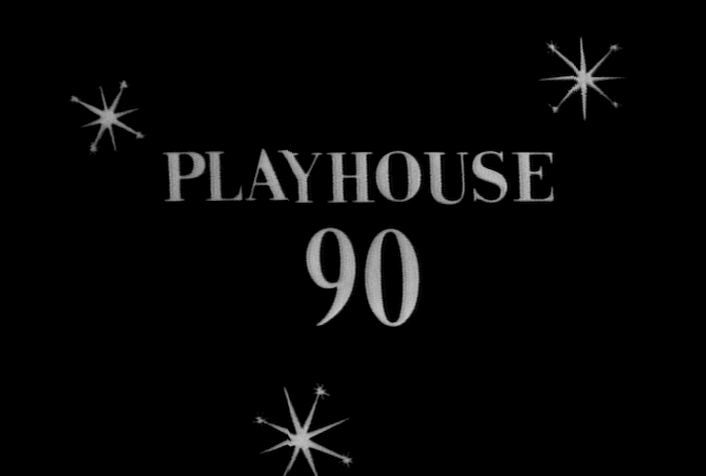
UCLA Film & Television Archive presents From Television City in Hollywood... Playhouse 90, a rare look at the landmark television series on its 60th anniversary. This free event takes place October 1, 2 and 16 at the Billy Wilder Theater with Matthew Weiner and Robert Butler in person.
Guest writer Molly A. Schneider delves into the history of the “Golden Age” anthology drama. Schneider is a television historian and a teacher of media studies. She received her Ph.D. from the Screen Cultures Program in the Department of Radio/Television/Film at Northwestern University. Her current project is a cultural history of the midcentury television anthology drama, with a particular focus on the ways the format intersects with ideas about Americanness.
Playhouse 90 at 60: A Giant Step and a Last Gasp
In 1956, a tuxedoed Jack Palance hosted the premiere episode of CBS’ new series Playhouse 90, announcing, “Ladies and gentlemen, you’re at an opening night. Tonight television takes the giant step.” Indeed, Palance promised that the show would mark the beginning of a significant new contribution to the American airwaves. This weekly 90-minute program would be, he declared, “the most important new dramatic series in television.”
Playhouse 90 (CBS, 1956-1960) was one of the most celebrated examples of the midcentury phenomenon called the anthology drama. Beginning in radio and moving to television, anthologies were comprised of individual, self-contained plays with different settings, characters, and scenarios each week. They enjoyed a brief heyday in the 1950s as perceived platforms for “quality” dramatic programming, and Playhouse 90 occupied the top of a list of prominent programs that included Westinghouse Studio One, Philco-Goodyear Television Playhouse, and Kraft Television Theatre. Playhouse 90 would produce many of the most highly regarded television plays of the period, including Rod Serling’s Requiem for a Heavyweight (1956) and JP Miller’s Days of Wine and Roses (1958). It also produced some of the most controversial dramas on television at the time, including A Town Has Turned to Dust (1958), one of Serling’s attempts to dramatize the murder of Emmett Till.
There is a kind of romanticism that surrounds the series, a reverence for what many feel it attempted to do for American television and for American culture. To be sure, not every episode was a masterpiece. Several were panned, and many others were regarded with mixed esteem. But Playhouse 90 became endowed with a set of profound hopes about what television could do and what it could be. It came to symbolize, for many, the great potential of the medium to provide mature, well-crafted, and socially relevant drama to American audiences in their own homes. Legendary New York Times critic Jack Gould noted, “In ‘Playhouse 90,’ in its successes and failures, there was a sustained and genuine effort to use TV as an arm of creative theater. CBS was the place of excitement, the place that was using television to add something distinctive and meaningful to our culture.”1
UCLA Film & Television Archive’s screening series From Television City in Hollywood…Playhouse 90, which commemorates the 60th anniversary of the program’s premiere, features six episodes that are each illustrative of different facets of the project that was Playhouse 90. Playwrights like Rod Serling and directors like John Frankenheimer, along with producers like Martin Manulis and Fred Coe and countless performers and technicians, strove to ask large questions and confront complex problems while pushing the artistic, technological, and cultural boundaries of television.
Cold War Dramas: Two by Rod Serling
Although Rod Serling’s name is nearly synonymous with his anthology series The Twilight Zone (CBS, 1959-1964), Serling was already one of the most celebrated television playwrights in the United States well before The Twilight Zone premiered. His Playhouse 90 scripts especially solidified this reputation. Serling would write 11 teleplays for Playhouse 90, including both adaptations and original stories. He would write the first episode, and he would write the last. Gould referred to Serling’s relationship with Playhouse 90 as “perhaps the most consistently fruitful partnership in television theatre.”2 Serling quickly established himself as a fierce commentator on topics of cultural concern, and, as demonstrated by his Cold War-themed plays, he was deeply troubled by the effects of violence, hatred, and cultural fear on the state of humanity.
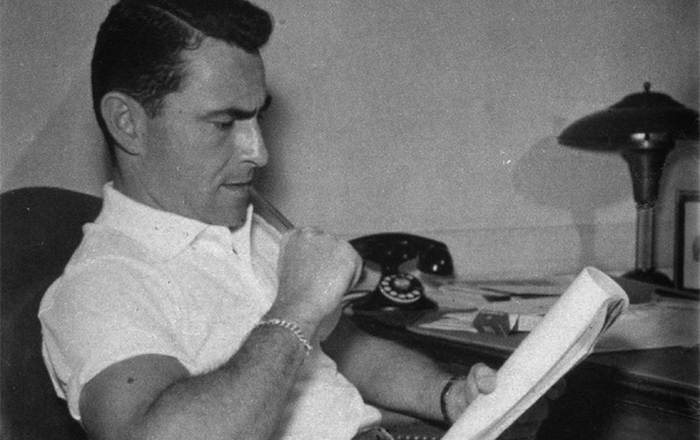
Writer Rod Serling
The premiere episode of Playhouse 90, “Forbidden Area” (1956), imagines a potential near future in which a Soviet saboteur has infiltrated the United States Air Force in order to disable American air defenses long enough to allow an attack on U.S. soil. Ultimately, after the attack is prevented, the American president must decide whether he will annihilate the retreating Soviet Union or practice “forbearance in victory” in order to safeguard the potential for world peace. The play was directed by John Frankenheimer and stars Charlton Heston, Tab Hunter, Diana Lynn, and Vincent Price.
Serling, a World War II paratrooper, would take war as the subject of his teleplays on numerous occasions. In a manner that would come to characterize much of Serling’s work, “Forbidden Area” acknowledges the dangers and fears conjured by the Cold War, but ultimately calls for temperance and restraint in the name of preventing needless bloodshed and worldwide destruction.
Serling would again appeal to reason and humanity in the 1957 episode entitled “The Dark Side of the Earth.” The story dramatizes the 1956 Hungarian uprising against Soviet occupation after World War II, focusing on the staunch Soviet Colonel Paul Sten (Van Heflin). When Sten’s son, a Soviet lieutenant, is killed in a firefight, it is revealed that he had secretly switched sides and joined the Hungarian resistance. Colonel Sten must endure both the pain of losing his son and the confusion of having fathered a so-called traitor to his country.
The depiction of a Soviet colonel as a sympathetic figure, albeit a flawed one, provides a complexity rarely ascribed to “the enemy” during the Cold War. To be sure, the Soviets as a military force are portrayed in the play as ruthless occupiers who torture and kill even children, but Sten reveals a conscience caught up in the system. “The Dark Side of the Earth” reminds us that our “enemies” are also people with lives they fear for and families they love. It resists a too-easy dehumanization of opponents, a bold and even controversial sentiment for which several viewer letters expressed appreciation.
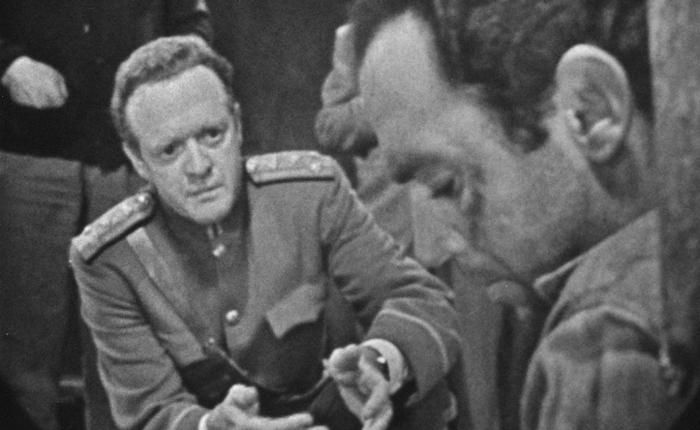
Van Heflin and Jerry Paris in Playhouse 90: "The Dark Side of the Earth" (CBS, 09/19/1957)
As a violence-weary Hungarian named Anna Rojas (Kim Hunter) says to Colonel Sten in a moment of strained but shared understanding, “The death of any human being is a pity.” Sten’s anguished account of looking upon his dead son’s body – recognizable, and yet wholly unfamiliar – reduces the colonel to a grieving father who must nonetheless confront his own role in the violence of war and its aftermath. Even the engineers of war are ultimately its victims. Serling would revisit this theme many times, arguing over and over that the largest tragedy of war – whether the “hot” or “cold” kind – is not only the suffering it causes, but the indelible residue of inhumanity it leaves on the world.
Two by John Frankenheimer
Like Serling, director John Frankenheimer also became a fixture of Playhouse 90. Overall he helmed over 25 episodes, including many of the most celebrated productions. He would recall in 1996, “I know that the ‘Playhouse 90’ years were the best years of my life.”3 Frankenheimer’s television direction became known not only for its dynamic use of space, inventive camera direction, and often virtuosic coordination of both live and taped productions, but also for a recurring mood of discomfort, struggle, and alienation.
Adapted by Horton Foote from the William Faulkner story, “Old Man” (1958) follows a prisoner on a chain gang (Sterling Hayden), billed only as “Tall Convict,” who is tasked with rescuing a pregnant woman (Geraldine Page) in a flood. As the two become lost and make their way through the diluvian landscape, they are confronted with questions about the relationship between work, independence, desire, and freedom. The play affirms the convict’s ultimate powerlessness against the forces of both nature and society when, upon reporting back to the chain gang, he is rewarded with an extra 10 years added to his sentence.

Sterling Hayden in Playhouse 90: "Old Man" (CBS, 11/20/1958)
Frankenheimer and his team famously flooded a studio at CBS Television City in Hollywood – a phenomenal logistical feat – in order to achieve the effect of the rolling floodwaters of the swollen Mississippi. Shot on the relatively new format of video tape, “Old Man” is also often credited with pioneering the practice of video editing.
“Old Man” is physical. It’s kinetic. It’s tactile. As is typical of Frankenheimer’s signature style, it is often exhaustingly strenuous. A scene in which the convict struggles to carry the young woman through the water, dropping her twice and all but throwing her on the muddy bank as she screams in labor pains, is almost unbearable. But, as is likewise typical of Frankenheimer’s work, “Old Man” is also contemplative. Like the convict’s extended sentence, it carries the weight of time – waiting, striving, seeking, but never quite finding salvation.
Like “Old Man,” “Journey to the Day” (1960) portrays characters who struggle to find their place in the world. Written by Roger O. Hirson, the play focuses on six patients in a psychiatric hospital and the young doctor charged with leading them in an experimental new group therapy program. The play was inspired by John Bartlow Martin’s 1959 book The Pane of Glass, a portrait of Columbus State Hospital that was itself compiled from Martin’s earlier six-part Saturday Evening Post feature entitled “Inside the Asylum.”
Playhouse 90’s sponsors and their ad agencies, and even some network executives, were resistant to airing a play about mental illness, fearing it would be too “hopeless” and “morbid” for their audiences. Producer Fred Coe and Associate Producer Robert “Bo” Goldman fought tooth and nail to get the teleplay on the air, insisting that mental illness was a topic in dire need of discussion in American society. They promised that it would be handled with the utmost integrity and care. Key to this goal, the production team argued, would be the choosing of actors capable of “interpreting drama in emotional terms” without sensationalizing the characters’ struggles.4 The play was cast with a host of distinguished actors – including prominent Method actors Vivian Nathan, Steven Hill, Mike Nichols, and Janice Rule, the latter of whom reportedly visited a mental institution to research her role. Frankenheimer was especially proud of the the actors’ performances, and he would later explain that his experience confronting mental illness in his own family had provided him with insight into the play.5
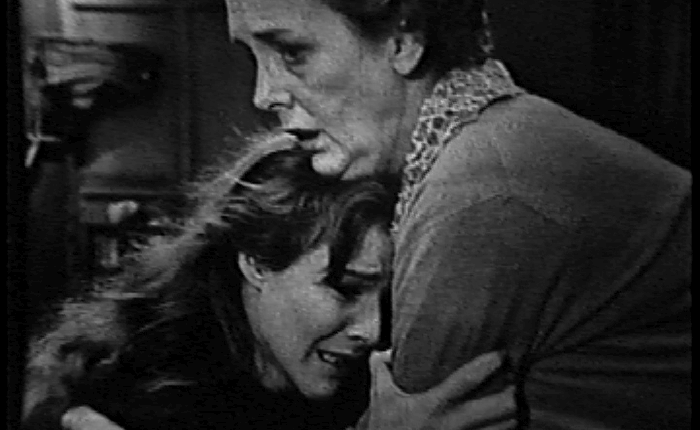
Janice Rule and Mary Astor in Playhouse 90: "Journey to the Day" (CBS, 04/22/1960)
A copious number of letters written in to Playhouse 90, including many from self-identified mental health professionals, praised “Journey to the Day” for presenting what many considered to be an honest, authentic, frank portrayal of mental illness. Some even asked for copies of the teleplay to use for training purposes at their institutions. “May we have more such dynamic portrayals?” one viewer asked. “The story of mental illness needs to be brought to the public.”6
Holocaust Dramas
The tendency of midcentury programs like Playhouse 90 to address matters of historical, social, and cultural importance meant that grave concepts like tragedy and injustice became frequent subjects. The Holocaust, still so raw in so many people’s minds, became a repeated topic. Playhouse 90 would present Holocaust dramas on two especially notable occasions, both causing controversy and vigorous moral battles.
“Judgment at Nuremberg” (1959), written by Abby Mann and directed by George Roy Hill, dramatizes the eponymous tribunals held after World War II to prosecute Nazi war crimes.7 Like many anthology dramas that were later adapted for the big screen, “Judgment at Nuremberg” is often better known for its later feature film iteration. Maximilian Schell, who appeared in both the television and film versions, would win an Oscar for his big screen portrayal of the German attorney assigned to defend the accused war criminals. However, although the 1961 film starring Spencer Tracy is indeed an acclaimed and intensely affecting piece of cinema, the original television play starring Claude Rains maintains a noticeably different energy. If the movie uses its nearly three-hour duration to convey the exhausting process of the trial proceedings, the teleplay utilizes the liveness of its broadcast to provide a sense of profound co-presence and close connection to the tragedies onscreen, a feeling of witnessing the trial as it unfolds in the courtroom.
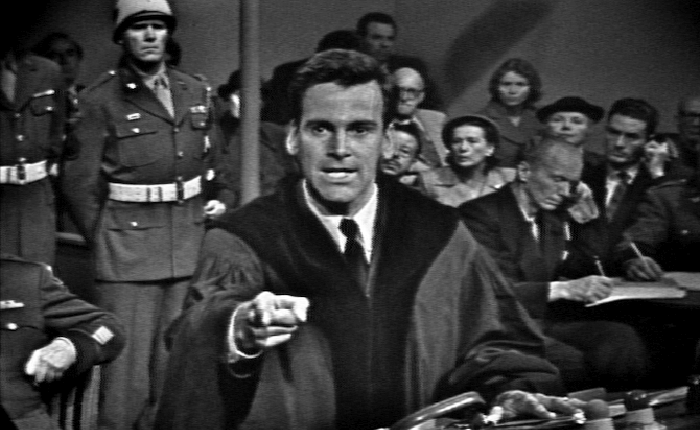
Maximilian Schell in Playhouse 90: "Judgment at Nuremberg" (CBS, 04/16/1959)
“Judgment at Nuremberg” is also one of the most notoriously censored television broadcasts of the midcentury period. Because one of the sponsors of Playhouse 90 was the American Gas Association, it was feared that references to the gas chambers used to exterminate prisoners in the concentration camps would create negative associations with the natural gas used to heat American homes and fuel cooking appliances. As a result, all mentions of the gas chambers were unceremoniously stripped from the live audio feed, leaving abrupt silences in the broadcast. These interruptions occurred several times, but in the most discussed instance, the voice of Claude Rains is briefly muted as he visibly says the words “gas chambers.” In another instance, the voiceover cuts out mid-sentence several times as archival footage clearly depicts gas chambers and gas canisters onscreen.
Reports differ about who demanded the censorship – the American Gas Association itself or an overzealous CBS executive – but it was swiftly cited in the press and by industry professionals as an example of the ways overwhelming commercial concerns could stifle quality television. Serling would repeatedly reference the incident in his crusade for artistic freedom and integrity. Jack Gould declared, “The futility of silly censorship seldom has been more vividly demonstrated.”8 He would later refer to “Judgment at Nuremberg” as “the production that clumsily rewrote history so that the American Gas Association would not have to worry about reference to the gas ovens in which millions had perished.”9
Even despite these hamfisted efforts at propriety, however, “Judgment at Nuremberg” was an explosive and hard-hitting production. Its use of historical footage of the concentration camps is both moving and agonizing, and the fact that these harrowingly graphic images were permitted to be shown on primetime network television is truly remarkable. The skill involved in coordinating such a complex live production is likewise impressive.
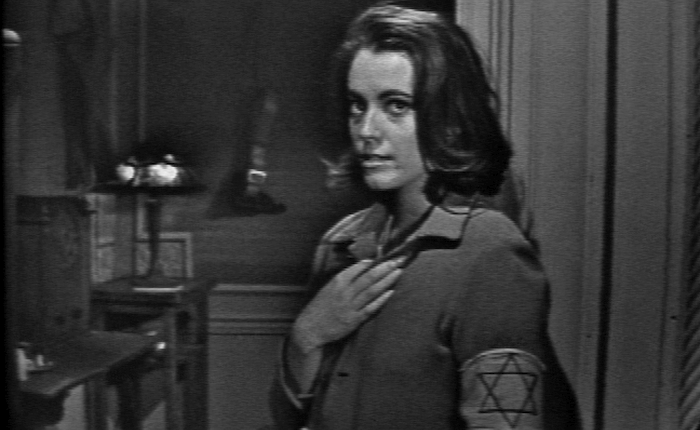
Susan Kohner in Playhouse 90: "In the Presence of Mine Enemies" (CBS, 05/18/1960)
The following year, Playhouse 90 presented another Holocaust-themed teleplay entitled “In the Presence of Mine Enemies” (1960). It was not only Serling’s final Playhouse 90, but the final Playhouse 90 ever produced. Starring a young Robert Redford as a conflicted Nazi soldier and Charles Laughton as an elderly rabbi, the play dramatizes the horrors of the Warsaw ghetto with striking intensity. It is a surprisingly frank and brutal portrayal of the atrocities of the Holocaust, surprising especially because it aired only a year after “Judgment at Nuremberg” had been so famously censored. Notably, “In the Presence of Mine Enemies” did not suffer the same prohibitions about references to the gas chambers, even though the American Gas Association remained as a sponsor.
However, “In the Presence of Mine Enemies” was still a hugely controversial and contested teleplay. It garnered a series of angry letters from viewers who objected to seeing the play’s horrifying themes on television or who were outraged at, among other things, the sympathetic portrayal of Redford’s Nazi soldier. Author Leon Uris, whose 1958 novel Exodus chronicled the plight of Jewish refugees and the founding of the state of Israel, wrote an inflammatory telegram to CBS executive Frank Stanton denouncing the play and demanding that the negatives be burned.10 Stanton stood by the play, pointing out the irony that an eminent writer and chronicler of the Holocaust would suggest an act of censorship comparable to Nazi book burning.11
Nonetheless, despite these battles, “In the Presence of Mine Enemies” received effusive praise from a large number of critics and audience members. Many specifically lauded the play, its author, and the network for managing to defy the standards of censorship that so often prevented challenging drama from ever seeing the airwaves. As the final episode of Playhouse 90, then, “In the Presence of Mine Enemies” represents both a perceived triumph and an acutely felt defeat for the program.
The demise of Playhouse 90 in 1960 marked, for many, not only a blow to quality television drama, but also a blow to national culture at large. It represented one of the last nails in the coffin of what had even then been thought of as a dying “Golden Age” of anthology drama. Very few anthologies remained as the 1960s moved forward. Figures like Serling considered this a tragedy for American television and for an American audience that was rapidly being deprived of a national dramatic forum. CBS executive Charles M. Underhill later mourned “[t]he golden age of television…which ‘Playhouse 90’ began to tap and which was cut off.”12 Author and playwright Gore Vidal would refer to the end of Playhouse 90 as “television’s last gasp.”13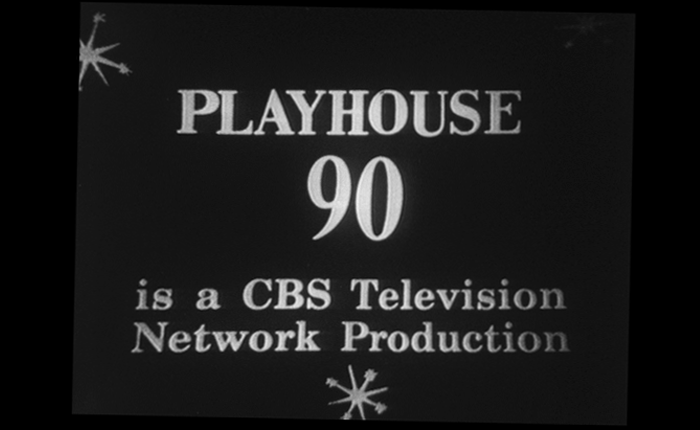
Playhouse 90 closing title
The legacy of Playhouse 90 is its role as both a touchstone and a bellwether for the state of television drama at the end of the 1950s. The show established a reputation for plays that were sophisticated, daring, and bold. It cultivated scores of renowned talent, and dedicated audiences looked to its creators to challenge the limits of what could be done on the small screen. Even when they missed the mark, the teleplays often raised powerful discussions – not only about the many social and historical issues they addressed, but also about the role of television in American culture. Thus, Playhouse 90’s significance lies not only in its triumphs, but in the ways its creators and its audiences became so deeply invested in its potential.
One wonders how Playhouse 90 would have addressed subsequent issues of societal concern if it had remained on the air. How would playwrights like Serling have dramatized 9/11 and the “war on terror”? How would a director like Frankenheimer have approached a teleplay about the Great Recession? How hard would a producer like Fred Coe have had to fight to air a show about gun violence and its roots? Or the #blacklivesmatter movement? Or LGBTQ rights? Or the crisis in Syria? The void left by Playhouse 90, which weighed so heavily on the program’s advocates, has never been completely refilled. Certainly many television programs have endeavored to wage social commentary or examine current topics of importance. Many have succeeded. But the unique ways Playhouse 90 and some of its fellow anthology dramas tackled these issues, specifically through the format of the artistically ambitious and sociologically introspective dramatic teleplay, has only rarely resurfaced on American television. Even as we find ourselves in what has often been designated yet another new “Golden Age” of television programming, Playhouse 90 remains a historical project that has not been fully replicated.
Notes
1. Jack Gould, "The TV Teeter-Totter," New York Times, Mar. 14, 1965.
2. Jack Gould, "Ghetto Tragedy: Rod Serling's 'In the Presence of Mine Enemies' on 'Playhouse 90'," New York Times, May 19, 1960.
3. Qtd. in Susan King, “Anthology of Memories,” Los Angeles Times, Oct. 3, 1996.
4. Norman Felton teletype memo to Fred Coe, March 7, 1960, Box 22, Folder 1, Fred Coe Papers, 1949-1975, call number U.S. Mss 198AN, Wisconsin Center for Film and Theater Research, Wisconsin Historical Society Library-Archives, Madison, WI.
5. Charles Champlin, John Frankenheimer: A Conversation with Charles Champlin (Burbank, CA: Riverwood Press, 1995), 43-44.
6. Mrs. Irene Shelton postcard to Program Director, TV Station KNXT – Channel 2, postdate April 23, 1960, Box 22, Folder 9, Fred Coe Papers.
7. Specifically, the play depicts a fictional version of what has come to be known as the Judges’ Trial, wherein several former judges who had served under the Nazi regime were tried for their roles in failing to prevent Nazi atrocities.
8. Jack Gould, "TV Notebook: A Rewarding Interview and Other Shows Presented on the Small Screen," New York Times, May 3, 1959.
9. Jack Gould, “CBS and the Sponsors: The Network Endorses Policy Enabling Advertisers to Object to Content of Serious Dramas,” New York Times, Feb. 7, 1960.
10. Leon Uris telegram to Frank Stanton, May 19, 1960, Box 12, Folder 5, Rod Serling Papers, 1943-1971, call number U.S. Mss 43AN, Wisconsin Center for Film and Theater Research, Wisconsin Historical Society Library-Archives, Madison, WI.
11. Frank Stanton letter to Leon Uris, May 20, 1960, Box 12, Folder 5, Rod Serling Papers.
12. United States Federal Communications Commission Office of Network Study, Second Interim Report: Television Program Procurement, Part II (Washington, D.C.: U.S. Government Printing Office, 1965), 575. Qtd. in William Boddy, Fifties Television: The Industry and Its Critics (Urbana and Chicago: University of Illinois Press, 1993), 106.
13. “Television—a UCLA oral history project, 1996 March 8 : Gore Vidal/interviewer, Steven Scheuer,” video recorded March 8, 1996, inventory number VA20903, UCLA Film & Television Archive, Los Angeles, CA.
Bibliography
Boddy, William. Fifties Television: The Industry and Its Critics. Urbana and Chicago: University of Illinois Press, 1993.
Champlin, Charles. John Frankenheimer: A Conversation with Charles Champlin. Burbank, CA: Riverwood Press, 1995.
Coe, Fred Papers, 1949-1975. Call number U.S. Mss 198AN. Wisconsin Center for Film and
Theater Research, Wisconsin Historical Society Library-Archives, Madison, WI.
Gould, Jack. "CBS and the Sponsors: The Network Endorses Policy Enabling Advertisers To Object to Content of Serious Dramas." New York Times, Feb. 7, 1960, X13.
———. "Ghetto Tragedy: Rod Serling's 'In the Presence of Mine Enemies' on 'Playhouse 90'." New York Times, May 19, 1960, 75.
———. "The TV Teeter-Totter." New York Times, Mar. 14, 1965, X19.
———. "TV Notebook: A Rewarding Interview and Other Shows Presented on the Small Screen." New York Times, May 3, 1959, X17.
King, Susan. “Anthology of Memories.” Los Angeles Times, Oct. 3, 1996, 1.
Serling, Rod Papers, 1943-1971. Call number U.S. Mss 43AN. Wisconsin Center for Film and
Theater Research, Wisconsin Historical Society Library-Archives, Madison, WI.
“Television—a UCLA oral history project, 1996 March 8 : Gore Vidal/interviewer, Steven
Scheuer.” Video. Recorded March 8, 1996. Inventory number VA20903. UCLA Film & Television Archive, Los Angeles, CA.
United States Federal Communications Commission Office of Network Study. Second Interim Report: Television Program Procurement, Part II. Washington, D.C.: U.S. Government Printing Office, 1965.
< Back to the Archive Blog






 Mobile Navigation
Mobile Navigation

